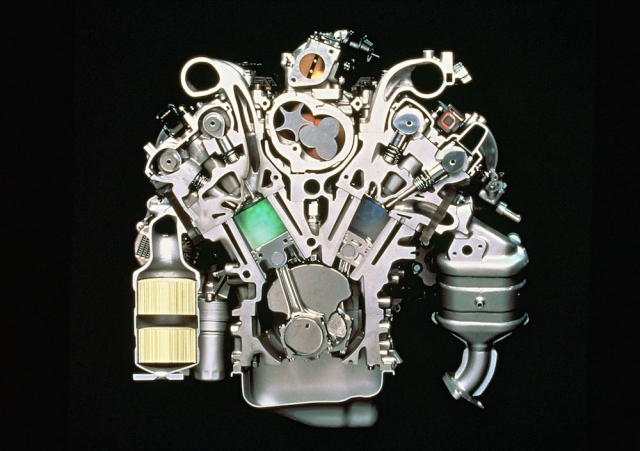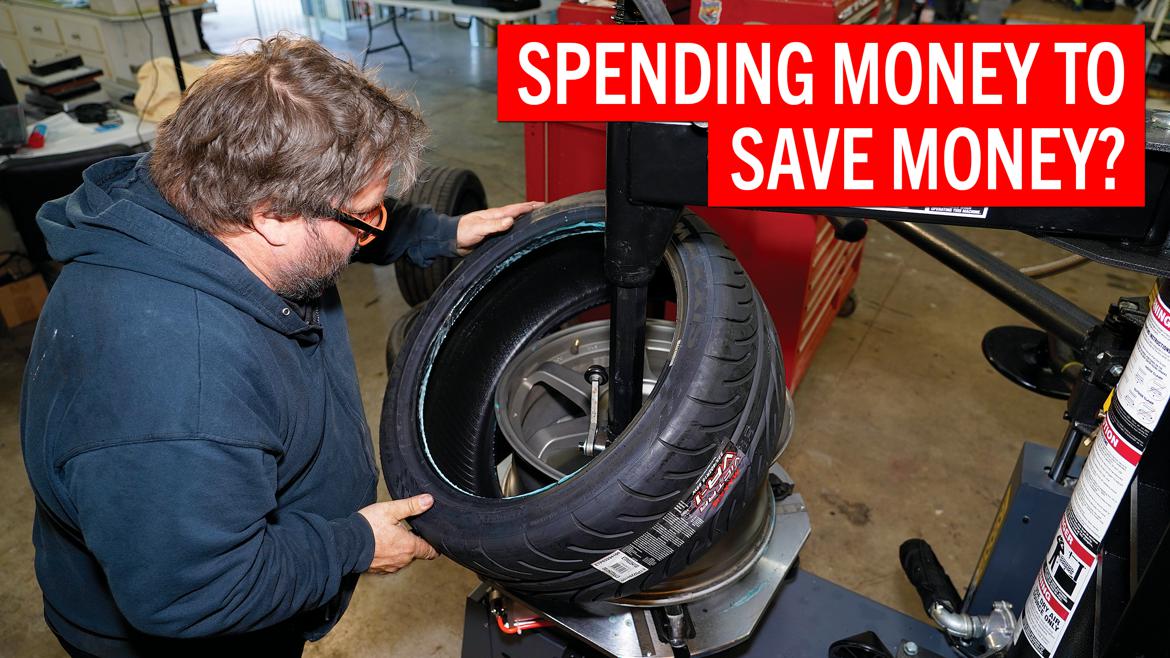
Sure, the window sticker says that a 2.0-liter VC-Turbo equipped Altima (a naturally-aspirated 2.5-liter unit is also available) is good for 236 horsepower and 267 lb.-ft. of torque, but if you splurge a little bit and select Premium at the pump, you'll get an extra 12 horsepower and 6 lb.-ft. of torque–at least according to the spec sheet Nissan supplied.
Also of …
Read the rest of the story
I think the VC-Turbo is some seriously cool tech, but I kind of feel like Nissan is squandering it.
The engine can literally change its compression ratio on the fly by adjusting its displacement, and somehow that doesn't make the car more fun to drive.
This is the tech they announced in 2016 and started using in 2017 with pretty 'meh' reviews? But now its just tricked down to the Altima?
It seems like a lot of extra complexity for an engine that effectively makes the same power and gets the same mileage as a typical 2.0L 4cyl turbo

Duke
MegaDork
5/3/21 2:55 p.m.
ProDarwin said:
This is the tech they announced in 2016 and started using in 2017 with pretty 'meh' reviews? But now its just tricked down to the Altima?
It seems like a lot of extra complexity for an engine that effectively makes the same power and gets the same mileage as a typical 2.0L 4cyl turbo
This. I looked up exactly what "VC turbo" meant when they had the commercial with the grumpy German guy a few years ago.
It seemed a looong way to go for not much, and high complexity / midprice Nissan is not a combination I'd be looking to add to my fleet.
It seemed a looong way to go for not much, and high complexity / midprice Nissan is not a combination I'd be looking to add to my fleet.
I guess that's kind of my point. I feel like this is the sort of stuff that goes into a supercar or even a sports car, but it's put in a midsize sedan and doesn't really actually add much to the driving experience.
Imagine how many people will buy this car and never know the complexities lurking under their hood.

Opti
Dork
5/3/21 7:07 p.m.
If it's got a Nissan CVT I'm out
Didn't the Altima we had in 2019 have the same tech? I barely remember the car; I think it was red?
E; T'was mistaken. It had something Nissan touted as ProPILOT Assist. In searching for the Altima article, I saw the one I wrote for the Maxima. I had completely forgotten that one. Poor Nissan.
Nissan still has yet to build an Altima that's as good as the mid-2000s SE-R. That was a truly "sporty" sedan (as the Maxima had recently given up that description), and it had 270hp in the excellent VQ35, with a 6-speed. I wasn't just a cosmetic package. Hell, as I recall it even had forged wheels made by Rays. Wasn't long after that Nissan lost its way and fell into the sporty-car gutter, clinging to the GT-R to give the company sporting bonafides.

In reply to irish44j (Forum Supporter) :
I owned an Altima SE of that vintage with the VQ V6 and a manual trans and the car was properly fun!
Colin Wood said:
I think the VC-Turbo is some seriously cool tech, but I kind of feel like Nissan is squandering it.
The engine can literally change its compression ratio on the fly by adjusting its displacement, and somehow that doesn't make the car more fun to drive.
So I watched a video on how this works, I don't see how it's changing the displacement?
The stroke length, and therefore swept volume is the same, it just happens lower in the cylinder, so the combustion chamber is larger, reducing how much the air/fuel mixture is compressed.
What am I missing?

Snrub
Dork
5/4/21 9:07 a.m.
Nissan deserves points for bringing variable compression to market, but it sounds like the feature is a small enough benefit that it's not noticeable.
Mazda's Skyactiv-X compression ignition engines seem like a similar story. Super cool concept and they've been out for a while, but they difference is small enough that they haven't bothered to sell it over here.
It kind of reminds me of when the Japanese manufacturers were all trying out new technologies, pushing the boundaries, etc. It's nice to see the spirit is still alive.
This feels like Mazda with the Miller cycle supercharged engines all over again. Staggering complexity under the hood of a commodity car is not a great recipe for longevity.

15-20 years from now, I would bet there are not too many VC-Turbos left on the road. It seems like the best approach to ICE these days is Toyota's: pursuit of thermal efficiency gains.
I have a mid 1990s kinematics textbook that had a drawing of a very similar variable compression engine. I believe that one was from SAAB. My guess is the added weight and complexity (worse, some of it is recpirocating weight) has kept it off the market.

Shaun
Dork
5/7/21 1:47 p.m.
z31maniac said:
Colin Wood said:
I think the VC-Turbo is some seriously cool tech, but I kind of feel like Nissan is squandering it.
The engine can literally change its compression ratio on the fly by adjusting its displacement, and somehow that doesn't make the car more fun to drive.
So I watched a video on how this works, I don't see how it's changing the displacement?
The stroke length, and therefore swept volume is the same, it just happens lower in the cylinder, so the combustion chamber is larger, reducing how much the air/fuel mixture is compressed.
What am I missing?
I had to look it up and can not relay a definitive answer- In fact I am more confused about how the displacement of this engine is calculated now, but I am pretty sure its because the engine has aspects of a Atkinson cycle so the piston is traveling along the bore in a more complicated (not fixed?...) manner than an Otto cycle engine. This article and comments didn't help me get it, but I think the correct info is contained therein.
In reply to Shaun :
Displacement is strictly bore/stroke/number of cylinders.
Once you get into talking about Miller/Atkinson cycle engines, you're talking about technicalities - they are just four stroke engines that close the intake valve later than optimal, like an old Crane Cams Economizer system.
@ Colin. Not sure what you are saying here.
So, is this trick engine give the Altima athletic prowess?
Pete. (l33t FS) said:
In reply to Shaun :
Displacement is strictly bore/stroke/number of cylinders.
Once you get into talking about Miller/Atkinson cycle engines, you're talking about technicalities - they are just four stroke engines that close the intake valve later than optimal, like an old Crane Cams Economizer system.
Yep, disappoints me to see a writer for the mag incorrectly identify what's going on with this engine.
In reply to z31maniac :
It brings up an interesting idea, though.... in a forced induction engine, can you have effectively more displacement with a low compression ratio, because the clearance volume is larger? Airflow into the engine is not tied to displacement like with a naturally aspirated engine, after all.
You are mixing up compression ratio and displacement. Displacement is a constant CR is changed by many things including forced induction and the size of the dome of a cylinder.

Shaun said:
z31maniac said:
Colin Wood said:
I think the VC-Turbo is some seriously cool tech, but I kind of feel like Nissan is squandering it.
The engine can literally change its compression ratio on the fly by adjusting its displacement, and somehow that doesn't make the car more fun to drive.
So I watched a video on how this works, I don't see how it's changing the displacement?
The stroke length, and therefore swept volume is the same, it just happens lower in the cylinder, so the combustion chamber is larger, reducing how much the air/fuel mixture is compressed.
What am I missing?
I had to look it up and can not relay a definitive answer- In fact I am more confused about how the displacement of this engine is calculated now, but I am pretty sure its because the engine has aspects of a Atkinson cycle so the piston is traveling along the bore in a more complicated (not fixed?...) manner than an Otto cycle engine. This article and comments didn't help me get it, but I think the correct info is contained therein.
I believe it changes the stroke length slightly as well.
In reply to MadScientistMatt :
I don't believe it does.
https://www.nissan-global.com/EN/TECHNOLOGY/OVERVIEW/vc_turbo_engine.html
dean1484 said:
You are mixing up compression ratio and displacement. Displacement is a constant CR is changed by many things including forced induction and the size of the dome of a cylinder.
No, he understands it, he's making a point about increasing atmospheric pressure in the combustion chamber having the same effect as increasing displacement. Of course, technically it doesn't, but that's the point of forced induction. More work out of a smaller package or much more work out of the same package.
Kind of like how I believe a rotary is really a 2.6L engine, so it's power and fuel numbers are really absymal when looking at it that way. 
In reply to z31maniac :
Right. More clearance volume normally means more residuals in the chamber, assuming a given volumetric efficiency.
I'm wondering, though, if, say, part of the reason Audi ran sub-7:1 compression in their Group B cars, even the 4v head ones, was because they had unlimited mass flow and boost, just a displacement limit. At compression ratios that low, the clearance volume becomes significant relative to the displacement, and on the witches' brew of fuels they were using detonation should not have been an issue even at 10:1.
Idle thoughts unrelated to production cars 35 years later.
In reply to Pete. (l33t FS) :
That's like Model T levels of compression.
I've always wondered why with turbo motors they go with lower compression and more boost vs more compression and less boost.
But I'm not a power train engineer so I don't know all the intricacies.

Shaun
Dork
5/7/21 8:21 p.m.
In reply to z31maniac :
I'm not a powertrain engineer either and I believe there are (mayby 'were' at this point in powertrain development is more accurate) power making advantages to low compression because a turbo charged engine with a lower compression ratio has more room and time to have shoved into it, at the mowar pressure the better, fuel and atmosphere to be exploded. I think there were significant charge cooling advantages as well as more fuel evaporating for more time sucks up more heat. Drivability, emissions, efficiency, longevity, and lots of other stuff is not as good as it could be at for sure. These days direct injection, better sensing, way way way faster ignition timing control, improvements in materials, variable valve timing, (apparently!) even variable compression ratios, and improvements in understanding what the heck is going on in there, have lead to much higher compression ratios in turbo charged guzzoline engines. I think the anyone can buy one 6 banger BMW turbos run at 11 /1? . Whereas my antique 1996 Volvo T5 is a very spongy 8.5/1.... That said, If ultimate power is the primary goal a lower compression ratio is still going to give more room and time for stuff that explodes to be shoved in there.








































